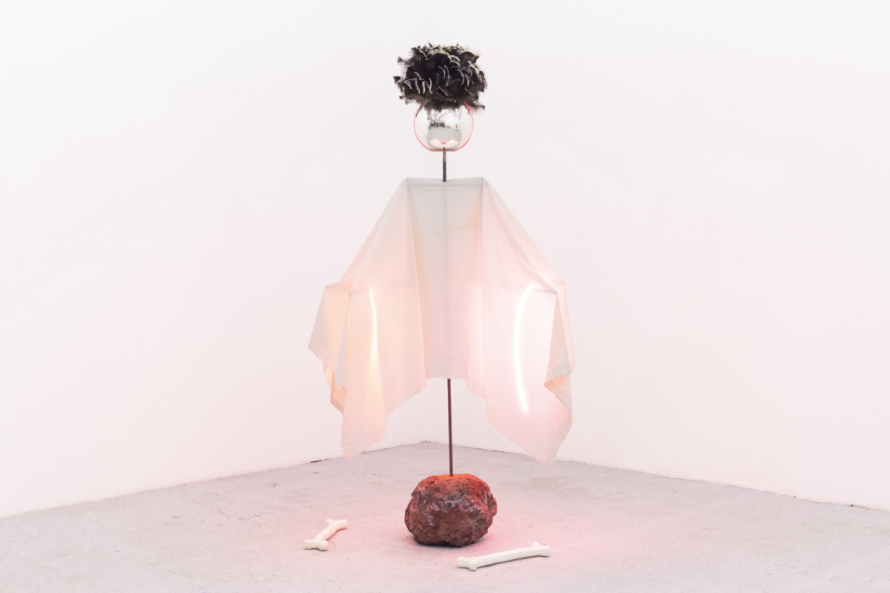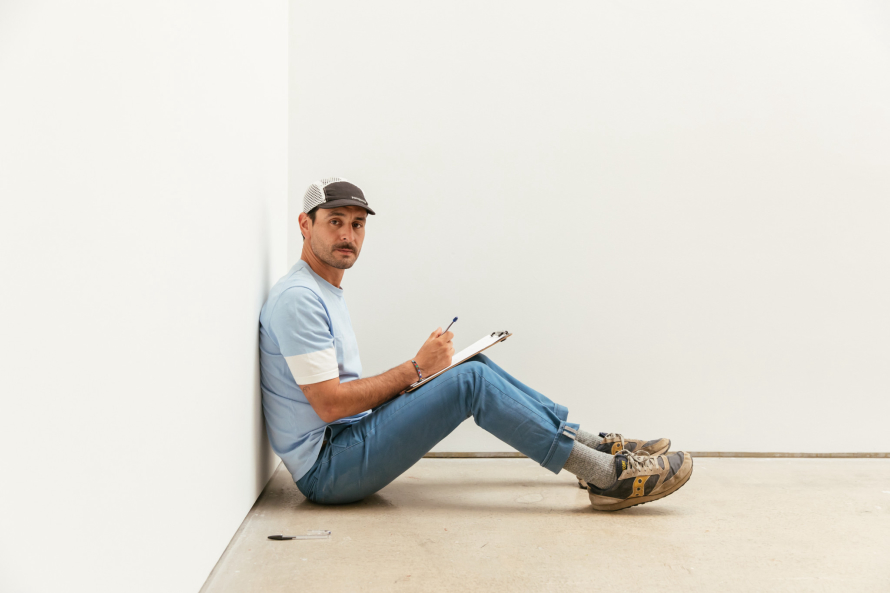
Gabriel Rico’s solo exhibition “Unity in Variety,” the inaugural show in the newly opened Institute of Contemporary Art in San Diego, is embedded into a landscape of an unspecified time and place. In reference to the surrounding beaches and deserts, the Guadalajara-based artist has partly covered the floor with sand and littered it with objects that suggest a future civilization looking back at a misguided past. A lone CD and a bag of Doritos lie partially buried while sheets of gold foil appear to have gotten caught in foraged tree branches; the crumbling sheets feel less like precious metal than bits of wind-blown rubbish . Luminous neon hangs from the ceiling in the shapes of letters and numbers, essential human inventions that mark a textural contrast to burnt stumps of wood below. (Those particularly resonate in San Diego, a region increasingly prone to wildfires in the face of climate changes). And rather than flesh-and-blood people, Rico’s landscape has only assemblages of steel rebar bodies with digital screens for faces, suggesting, perhaps, that humanity has run its course.

However, “it’s not a prediction of the future,” Rico says, “but more or less our present—this is the science fiction movie that’s happening right now.”
Rico’s post-surrealist ecosystem is an ideal debut for the ICA San Diego, a new two-site institution that occupies both the former Lux Contemporary Museum space in Encinitas, and the former San Diego Art Institute in the heart of the city’s famed Balboa Park. The art museum’s first season is titled, “In This Broad Earth of Ours,” a line borrowed from Walt Whitman’s Leaves of Grass.
The phrase “speaks to how our lives are intertwined with the environment, from social, cultural, historical or political perspectives,” according to executive director Andrew Utt. Through their work, he says, artists like Rico “will promote action: Visitors will be asked to respect the land, eat wisely from the ocean, consume intelligently and envision unification of all things large and small.” In the ICA’s commitment to honoring the Latinx culture and heritage of the area, unification also applies to its audience: all programming is bilingual, developed in Spanish first before being translated into English.

The ICA’s dual interests in land and community naturally intersect on themes of migration and borders, both of which feature prominently in Rico’s installation. Absent of people, his landscape are abound with animals that reside in both Southern California and Baja Norte—twin terrains on either side of the U.S.-Mexico border. Taxidermied birds, borrowed from the nearby San Diego Natural History Museum, appear to have crashed into the installation’s upright planes of glass and been knocked cold. In their seeming inability to see this barrier, “Gabriel makes an important point about borders: they’re invisible,” Utt says. “So are the borders in our minds, where we construct these ideas of space between people, mentalities, ideas or languages. In many cases, we need to tear those down, and rethink how we engage.”
The ICA itself illustrates how borders can do little to stop the passage of time, nor the migration of cultures. It sits on land that was once stewarded by the indigenous Kumeyaay people, who were ultimately colonized and displaced by the Spanish. The land changed hands between Spain and Mexico before joining the United States, and in the 20th century, it was American architects who eventually constructed the ICA building in a Spanish Mission Revival style. As Rico’s installation explores the possibilities of what’s coming next, he offers a reminder of the impermanence of the human condition, and the inevitability of change. In the face of shifting demographics, there is unity in variety, and beauty in it, too.










 in your life?
in your life?

